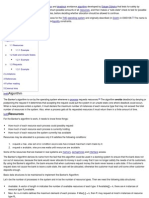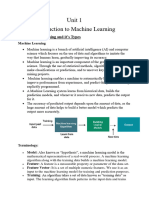Banker's Algorithm
Uploaded by
Bonam Mani KrishnaBanker's Algorithm
Uploaded by
Bonam Mani KrishnaBanker's Algorithm 1.multiple instances of resource types IMPLIES cannot use resource-allocation graph 2.
banks do not allocate cash unless they can satisfy customer needs when a new process enters the system 3.declare in advance maximum need for each resource type 4.cannot exceed the total resources of that type 5.later, processes make actual request for some resources 6.if the the allocation leaves system in safe state grant the resources 7.otherwise, suspend process until other processes release enough resources Banker: Data Structures #define MAXN 10 #define MAXM 10 int Available[MAXM]; int Max[MAXN][MAXM]; int Allocation[MAXN][MAXM]; int Need[MAXN][MAXM]; /* /* /* /* /* /* /* maximum number of processes */ maximum number of resource types */ Available[j] = current # of unused resource j */ Max[i][j] = max demand of i for resource j */ Allocation[i][j] = i's current allocation of j*/ Need[i][j] = i's potential for more j */ Need[i][j] = Max[i][j] - Allocation[i][j] */
Notation: X <= Y iff X[i] <= Y[i] for all i (0,3,2,1) is less than (1,7,3,2) (1,7,3,2) is NOT less than (0,8,2,1) Each row of Allocation and Need are vectors: Allocation_i and Need_i Banker: Example Initially: Available A B C 10 5 7 Later Snapshot: Max - Allocation = Need A B C A B C A B C P0 7 5 3 0 1 0 7 4 3 P1 3 2 2 2 0 0 1 2 2 P2 9 0 2 3 0 2 6 0 0 P3 2 2 2 2 1 1 0 1 1 P4 4 3 3 0 0 2 4 3 1 Banker: Safety Algorithm consider some sequence of processes if the first process has Need less than Available it can run until done then release all of its allocated resources allocation is increased for next process if the second process has Need less than Available ... then all of the processes will be able to run eventually IMPLIES system is in a safe state
Available A B C 3 3 2
Banker: Safety Algorithm STEP 1: initialize Work := Available; for i = 1,2,...,n Finish[i] = false STEP 2: find i such that both a. Finish[i] is false b. Need_i <= Work if no such i, goto STEP 4 STEP 3: Work := Work + Allocation_i Finish[i] = true goto STEP 2 STEP 4: if Finish[i] = true for all i, system is in safe state Banker: Safety Example Using the previous example, P1,P3,P4,P2,P0 satisfies criteria. Max - Allocation = Need <= Work Available A B C A B C A B C A B C P1 3 2 2 2 0 0 1 2 2 3 3 2 3 3 2 P3 2 2 2 2 1 1 0 1 1 5 3 2 P4 4 3 3 0 0 2 4 3 1 7 4 3 P2 9 0 2 3 0 2 6 0 0 7 4 5 P0 7 5 3 0 1 0 7 4 3 10 4 7 10 5 7<<< initial system Banker: Resource-Request Algorithm STEP 0: P_i makes Request_i for resources, say (1,0,2) STEP 1: if Request_i <= Need_i goto STEP 2 else ERROR STEP 2: if Request_i <= Available goto STEP 3 else suspend P_i STEP 3: pretend to allocate requested resources Available := Available - Request_i Allocation_i := Allocation_i + Request_i; Need_i := Need_i - Request_i STEP 4: if pretend state is SAFE then do a real allocation and P_i proceeds else restore the original state and suspend P_i Banker: Resource-Request Algorithm Say P1 requests (1,0,2) Compare to Need_1: (1,0,2) <= (1,2,2) Compare to Available: (1,0,2) <= (3 3 2) Pretend to allocate resources:
Max - Allocation = Need Available A B C A B C A B C A B C P0 7 5 3 0 1 0 7 4 3 2 3 0<<< P1 3 2 2 3 0 2<<< 0 2 0<<< P2 9 0 2 3 0 2 6 0 0 P3 2 2 2 2 1 1 0 1 1 P4 4 3 3 0 0 2 4 3 1 Is this safe? Yes: P1, P3, P4, P0, P2 Can P4 get (3,3,0)? No, (3,3,0) > (2,3,0) Available Can P0 get (0,2,0)? (0,2,0) < (2,3,0) Available Pretend: Available goes to (2,1,0) But ALL Needs are greater than Available IMPLIES NOT SAFE
You might also like
- Experiment:2.1: Write A Program To Simulate Bankers Algorithm For The Purpose of Deadlock AvoidanceNo ratings yetExperiment:2.1: Write A Program To Simulate Bankers Algorithm For The Purpose of Deadlock Avoidance6 pages
- 13 (A) Explain The Banker's Algorithm For Deadlock Avoidance With An Illustration. - Bituh100% (1)13 (A) Explain The Banker's Algorithm For Deadlock Avoidance With An Illustration. - Bituh6 pages
- In This Assignment Banker's Algorithm Is UsedNo ratings yetIn This Assignment Banker's Algorithm Is Used21 pages
- Methods For Handling Deadlocks: Mutual Exclusion Hold and WaitNo ratings yetMethods For Handling Deadlocks: Mutual Exclusion Hold and Wait7 pages
- Banker's Algorithm Is Used Majorly in The Banking System To Avoid Deadlock. ItNo ratings yetBanker's Algorithm Is Used Majorly in The Banking System To Avoid Deadlock. It18 pages
- Chapter 7: Deadlocks: Al-Mansour University College Software Engineering and Information Technology DepartmentNo ratings yetChapter 7: Deadlocks: Al-Mansour University College Software Engineering and Information Technology Department43 pages
- Raw Waveform Processing - BayesMap Solutions, LLCNo ratings yetRaw Waveform Processing - BayesMap Solutions, LLC3 pages
- InDesign CC21 Student Packet - P2 Conference PosterNo ratings yetInDesign CC21 Student Packet - P2 Conference Poster9 pages
- Write Protecting The Diskonchip 2000: Ap-Doc-011 Application NoteNo ratings yetWrite Protecting The Diskonchip 2000: Ap-Doc-011 Application Note4 pages
- Object oriented design knowledge principles heuristics and best practices Javier Garzã¡S 2024 scribd download100% (2)Object oriented design knowledge principles heuristics and best practices Javier Garzã¡S 2024 scribd download76 pages
- Multithreading Interview Questions: Click HereNo ratings yetMultithreading Interview Questions: Click Here37 pages
























































































